Extinction: Is Climate Change Causing a Mass Extinction?
9 minute read
Updated on: 09 Jun 2021
All living things, from animals to plants, fungi and bacteria, are grouped into species.
But many species are now struggling for survival. Because of melting sea ice, nearly all polar bears will be gone by 2100. And it’s not just polar bears: the rapidly changing climate is a threat to many species.

In fact, scientists now think the planet is facing a mass extinction, partly due to climate change. But what exactly does this mean, and why is it happening?
Scientists don’t know for sure how many species there are on Earth - it could be anything from 2 million to around a trillion! One study estimated that there are around 8.7 million species on Earth today.
The other 99%? Extinct. But what exactly does “extinct” mean?
Generally speaking, a species becomes extinct when there are no more individuals of that species left alive. The “lifespan” of a species varies, but scientists estimate that species exist for between 1 and 10 million years
.
A mass extinction event occurs when over 75% of all species on the planet disappear within a short period of geological time - typically less than 2 million years. From looking at the fossil record, there have been five mass extinctions in the last 540 million years or so
.
Scientists generally attribute these mass extinction events to multiple threats interacting together - often including unusual climates and natural disasters such as huge volcanic eruptions and asteroid impacts.
The most recent mass extinction dates back to 66 million years ago, which famously marked the end of the dinosaur age.
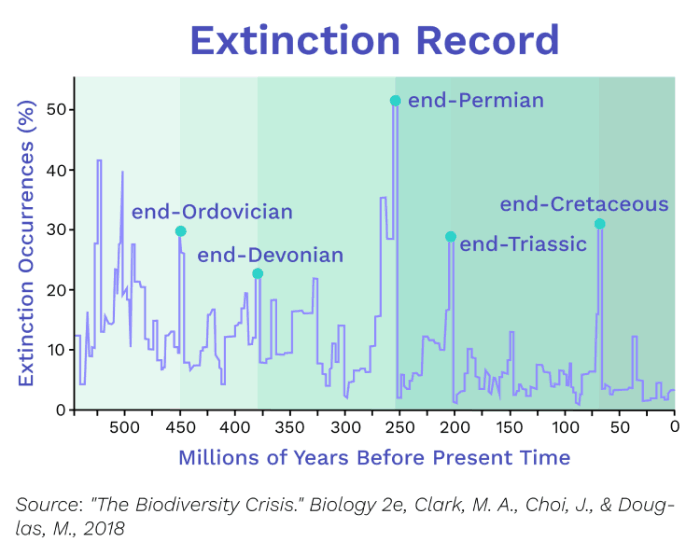
Extinction Record
Recent extinctions
While it is natural that species go extinct, the rate of extinction is increasing due to human activities and human-caused climate change
.
Since the 16th Century, at least 680 vertebrate species have been driven to extinction. These numbers may seem low, but humans have actually increased extinction rates by 1,000x above “natural rates” (the rate expected if humans weren’t around)
. Indeed, current extinction rates are comparable to the rates of previous mass extinctions
!
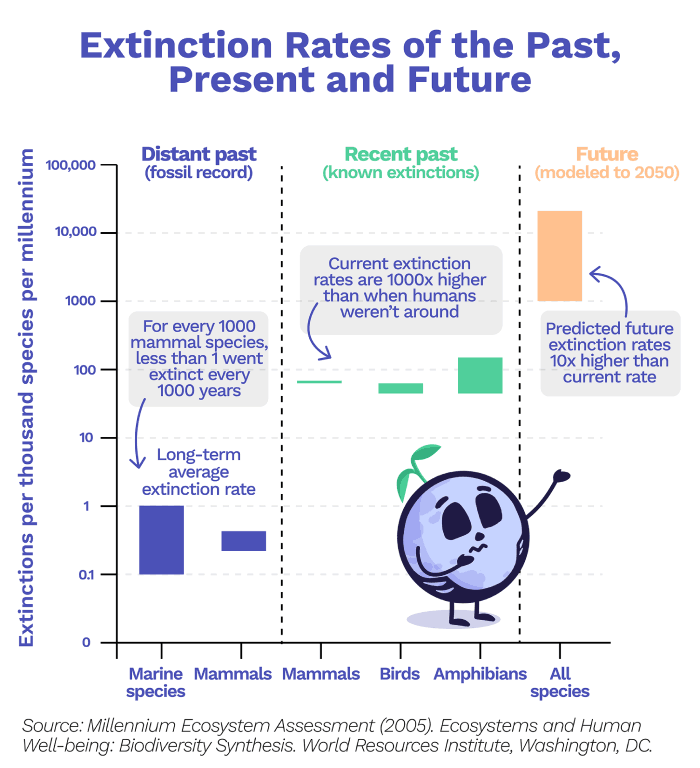
Extinction rates of the past, present and future
For this reason, many scientists think we are going through a sixth mass extinction. They believe we have entered a new geological epoch named the “Anthropocene”, so-called because of the ever-increasing human influence on Earth.

Comparing the magnitude of modern and past extinctions in different animal groups
Currently, the global average temperature is rising faster than ever recorded in the past. If we don’t act now, we could reach temperatures unseen in over 5 million years by as early as 2100.
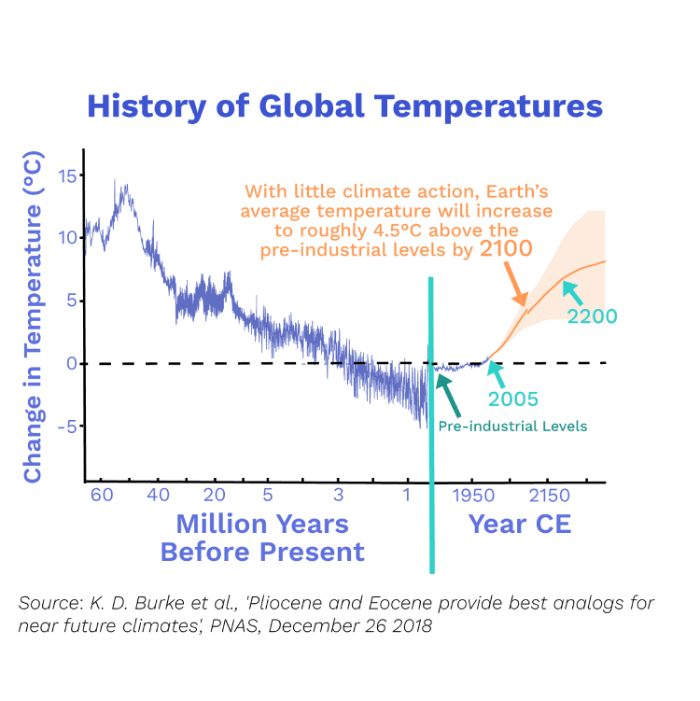
The global average temperature is rising faster than ever recorded in the past
Unfortunately, scientists predict many species currently on Earth are unable to keep up with this rate of change by adaptation.
Around 1 million plant and animal species are thought to be threatened with extinction, partly because global warming is happening so fast
.
The battle for survival is made harder by other threats from humans: things like pollution, hunting, and deforestation, which destroys the homes of many species.
Climate change can worsen the impacts from these other threats. One experiment found that population declines were 50x faster when threats acted together compared to when each threat acted individually
!
Extinctions in the present
Although it is difficult to single out the specific contribution of climate change to modern extinctions, it is clear that many population sizes are decreasing globally.
Between 1970-2014, the sizes of over 16,000 vertebrate populations from 4,000 species have declined by 60% on average.
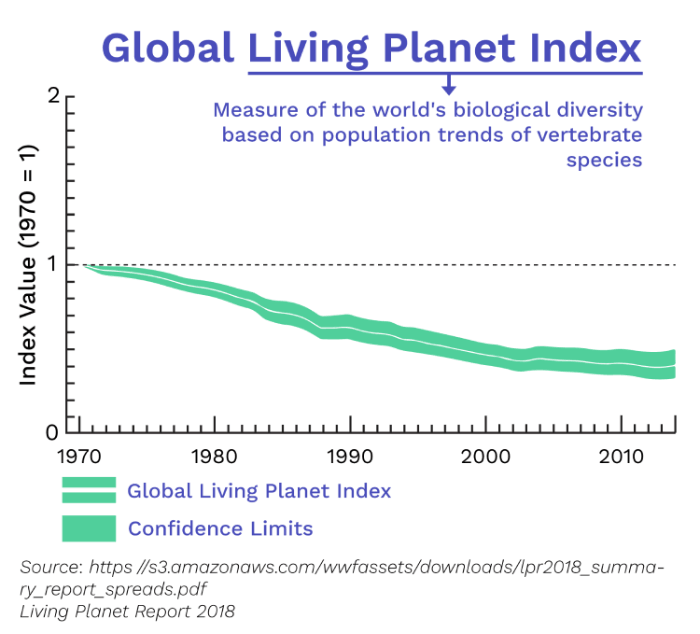
Living Planet Index
Without conservation efforts, any of these species could become “locally extinct”. This is where a species no longer lives in a particular area but still exists elsewhere in the world.
There is already much evidence for local extinctions happening due to climate change. As local extinctions build up, species edge ever closer to global extinction.
Extinctions of the future
Models used to predict the risk of extinction of different species are limited by computing power and must, therefore, make lots of assumptions (see our “Climate Predictions” course for more info). Additionally, to keep models simple, the effects of interactions between different species are often not considered
.
Despite these limitations, as well as variations between different places and species, predictions are often grim.
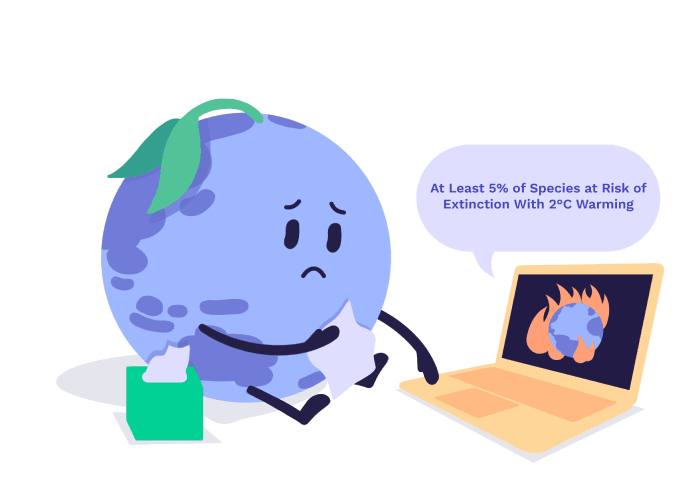
One study estimates that 5% of species would be at risk of extinction if the world warms by 2°C, and 16% would be at risk if this rises to 4.3°C. Not a great outlook!
But how does climate change actually cause population decline and extinction?
Direct negative impacts of climate change
Higher frequency and increased severity of extreme weather events are just some of the ways climate change can directly kill wildlife.
For instance, heatwaves in Australia cause koalas to die from dehydration as the leaves they eat dry up, whilst 23,000 flying foxes died from overheating in 2018.
While temperatures rising above a species’ level of tolerance is often the first impact that comes to our minds, other physical changes can increase stress on wildlife too.
Rises in sea level reduce habitat availability, especially in coastal areas and islands with shores at sea level. This means animals might have less access to food and living areas, which reduces their chance of survival
. For many forms of coastal wildlife, such as seabirds, this also results in fewer available breeding sites
.
One species recently driven to extinction by direct climate change impacts is the Bramble Cay melomys. The small island that this Australian rodent lived on was subjected to rising sea levels and worse flooding during storms. This led to dramatic habitat loss and ultimately wiped out the species
.
Seawater floods also make the land and water saltier. This is problematic for plants that aren’t adapted to salty environments as it causes water to be drawn out of their cells, dehydrating them
.
Indirect impacts through biological interactions
Climate change can also indirectly reduce population sizes, by changing pretty much every way different species can interact.
Altered species interactions are more likely to drive extinctions than direct effects of climate change. Loads of different species can interact in unimaginably complex ways
. If one species goes extinct, this could lead to the extinction of others, and so on
.
Let’s look at the rainforest in Puerto Rico as an example. The average daily maximum temperature has increased by 2°C since 1970, which has killed arthropods (a group of animals without backbones, including insects) due to heat stress
. The total weight of arthropods in the forest in 2013 was at least 4-8x less than in the 1970s
.
Lizards, frogs and birds which feed on arthropods have, therefore, reduced in numbers due to lack of food. For example, birds that eat insects were found to be 53% less common in 2005 than in 1990
. This shows how climate change can cause a cascade of declines throughout the food chain - and in such a short amount of time too
!
But it’s not just a problem of food availability. Besides eating and being eaten, species play many other important roles in ecosystems too - we’ll see more examples in the next two chapters.
Conclusion
We now know more about how climate change can negatively affect wildlife, and how declines of even just one species can impact an entire ecosystem.
There are many other threats to species besides climate change that need to be tackled, but solving climate change will reduce pressures on both human and wildlife populations! We’ll learn more about these solutions in other courses at ClimateScience.
Next Chapter

